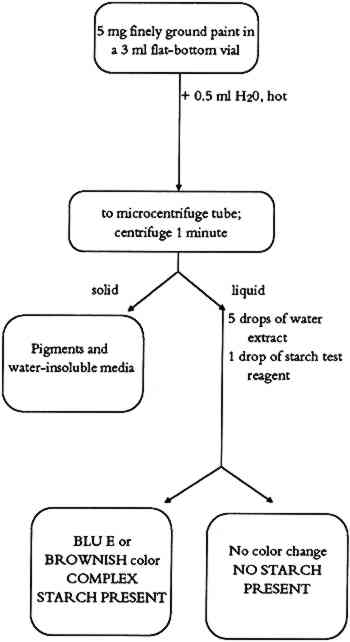BINDING MEDIA IDENTIFICATION IN PAINTED ETHNOGRAPHIC OBJECTSDUSAN STULIK, & HENRY FLORSHEIM
4 TEST FOR STARCHESStarch is present in all plant cells. Primary sources for starches are potatoes, rice, corn, wheat, and arrowroot. The starch granules are separated from these plants by milling and washing in water. Starch granules contain two polymers, amylase and amylopectin. Chemically, the amylase is a large linear polymer of 1,4-anhydroglucose. Amylopectin molecules are also based on the same anhydroglucose polymer, but they have a large number of short linear chains attached to the main polymer chain. The heating of dry starch to 160�-190�C produces dextrin. Both starches and dextrins are used as paste adhesives. In its more soluble form, starch can also be used as a binding medium for pigments. 4.1 METHODAn aqueous solution of starch gives a blue or brown color in a dilute solution of iodine. The active fraction of starch is amylose. The amylose exists as a coiled helix of poly α -D-glucose into which linear molecules can fit. In the presence of starch, iodine ions (I−) form a long chain of I−5 ions that occupy the center of the amylose helix. It is this dark blue I−5-amylose complex that provides proof of the starch in the paint sample (Vogel 1989). 4.2 PROCEDUREThe starch test flow chart is shown in figure 4. About 5 mg of finely ground paint sample or residue from the methylene chloride extraction is mixed with 0.5 ml of distilled water in a 3 ml flat-bottom vial. The resulting suspension is heated to a low boil on a hot plate. It is boiled for about 2 minutes and then allowed to cool to room temperature. The suspension is transferred into a microcentrifuge tube and centrifuged 1 minute. Five drops of supernatant are mixed with 1 drop of starch test reagent. The presence of starch is indicated by an immediate color change to blue or brown.
4.3 COMMENTSThis test identifies starch as a binding medium or adhesive in paint samples. The resulting color complex is usually blue, but different shades of brown color also indicate the |
